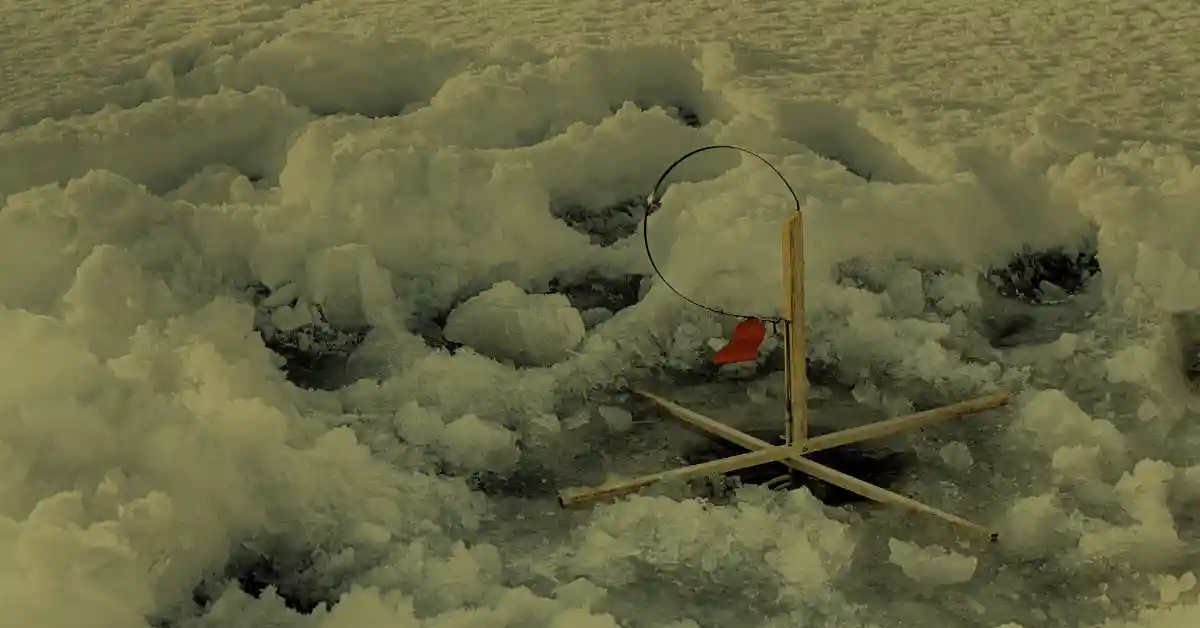It’s ice fishing season, so prepare to be transported to a world where peaceful frozen landscapes and the excitement of fishing collide. Keeping yourself safe is of utmost importance despite the stunning ice scenery. That’s why we’re putting together this extensive resource full of critical Ice Fishing Safety Advice. These Ice Fishing Safety Tips are intended to provide experienced and novice ice anglers with the information they require to safely enjoy their moment on the ice. Learn the fundamental Ice Fishing Safety Tips that will make your next ice fishing journey one to remember.
Understanding the Basics of Ice Formation
You must learn how ice forms and what elements contribute to its strength before you go ice fishing. Comprehensive, transparent ice is preferable over light, opaque glaze, which may be brittle. When moisture freezes slowly, air bubbles may escape, creating denser ice and a more transparent solid.
Checking Ice Thickness Before You Go
Before stepping onto any ice, understand how stout it is. A safe walking thickness of ice is 4 hairs, whereas 5-7 inches is recommended for driving on a snowmobile or all-terrain vehicle. The consistency of the ice may be determined by drilling test holes using an ice auger.
Gearing Up for Protection: Essential Equipment
It’s crucial to arm oneself with basic survival gear. Lifesaving equipment includes things like ice picks, throw ropes and life vests. Save your phone safe from wetness damage by storing it in a waterproof case.
Buddy System: Never Ice Fish Alone
Ice fishing is more fun and safer when done in a group. The buddy system assures that there will always be someone to help in a sticky situation. If you must go without company, let someone understand your itinerary and when you intend to return.
Dress for Success: Proper Clothing and Layering
Proper attire is important. Put on a watertight coat, thermal underwear, and a moisture-wicking base layer. Don’t leave home without your thermal underwear, cap, and gloves.
Knowing Ice Conditions: Color Matters
There are varied degrees of security associated with each hue of ice. The strongest ice has a transparent blue colour, whereas the weakest is white or opaque. Dismal ice may be unexpected since it has thawed and frozen again. Cloudy honeycombed ice calls for extreme vigilance.
Setting Up Your Ice Fishing Spot Securely
Carefully choose your fishing site. If there is any open moisture or cracks in the ice, it has likely broken recently. If you want to fish in a safe area, look for where other people are casting their lines.
Maintaining Distance: Safety Gaps Between Anglers
Maintain a respectful distance from another fisherman. Drilling holes more apart avoids congestion and reduces the likelihood of accidents.
Safeness First: Carry a Complete First Aid Kit
The safest of settings is not immune to accidents. Bandages, antiseptics, pain relievers, and required prescription prescriptions are crucial components of every first aid bag.
Monitoring Weather Conditions
Rapid shifts in the weather are possible. Maintain an eye out for weather reports and warnings. If you hear thunder or see the sky becoming black, get off the ice right away.
Avoiding Alcohol and Staying Hydrated
Alcohol lowers inhibitions and raises the danger of hypothermia. Drink warm drinks and dampness to remain hydrated on your excursion.
Ventilation in Ice Shelters: Preventing Carbon Monoxide Poisoning
Carbon monoxide poisoning may occur if not enough air is circulating in an ice shelter with a heater. Carbon monoxide detectors that are portable may be used as an additional security measure.
Fire Safety: Handling Heaters and Flames
Heaters should be used only in well-ventilated areas, on sturdy surfaces, and away from combustibles. Carry and learn how to use a fire extinguisher at all periods.
Emergency Planning: What to Do in Case of a Mishap
Despite best efforts, mishaps still occur. If you happen to go through the ice, you should understand how to keep yourself afloat by kicking your legs and how to use ice picks to lift yourself onto the ice so you can roll to safety.
Ice Fishing Safety Tips [FAQs]
-
How thick should the ice be before ice fishing?
Vehicles require ice at least 7 inches wide, whereas pedestrians need ice at least 4 inches thick.
-
Can I ice fish alone?
Ice fishing is more secure when done in pairs. Tell someone where you’re going if you really must travel alone.
-
What clothing should I wear for ice fishing?
Layer up with clothes that can wick away sweat and an impermeable shell.
-
How do I know if the ice is safe to fish on?
The safest ice has a clear blue colour, whereas white or grey ice poses more risk.
-
What should I do if someone falls through the ice?
Help them back onto the ice using ice picks so they can obtain quick medical assistance.
Conclusion: Embrace the Adventure Safely
These essential ice fishing safety leads may make or break your frozen fishing trip. Remember to prepare and be cautious while exploring ice terrain. Follow this proven ice fishing safety information to enjoy icy waters while being safe. Next, while you go ice fishing, remember these safety tips to have a fun and safe time.”











